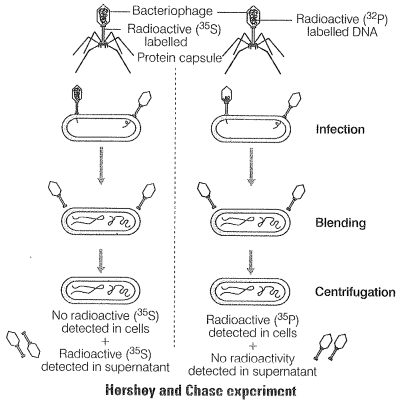Q. 13 Give an account of the Hershey and Chase experiment. What did it conclusively prove? If both DNA and proteins contained phosphorus and sulphur do you think the result would have been the same?
Hershey and Chase conducted experiments on bacteriophage to prove that DNA is the genetic material.

(i) Soe bacteriophage virus was grown on a medium that contained radioactive phosphorum and some in another medium with radioactive sulphur .
(ii) Viruses grown in the presence of radioactive sulphur contained radioactive DNA.
(iii) Similar viruses grown in presence of radioactive sulphur contained radioactive protein.
(iv) Both the radioactive virus types were allowed to infect E.coli separately.
(v) Soon after infection, the bacterial cells were gently agitated in a blender to remove viral coats from the bacteria.
(vi) The culture was also centrifuged to separate the viral particle from the bacterial cell.
Observations and Conclusions
(i) Only radioactive was found to be associated with the bacterial cell, whereas radioactive was only found in the surrounding medium and not in the bacterial cell.
(ii) This indicates that only DNA and not protein coat entered the bacterial cell.
(iii) This proves that DNA is the genetic material which is passed from virus to bacteria and not protein.
If both DNA and proteins contained phosphorus and sulphur, the result might change.
In case (i)
Radioactive and + Bacteriophage labelled protein capsule No radioactive
and Detected in cells + Radioactivity ( and ) detected in the supernatant
In case (ii)
Radioactive and labelled DNA + Bacteriophage radioactive and
Detected in cells + No Radioactivity detected in the supernatant

© 2025 GoodEd Technologies Pvt. Ltd.